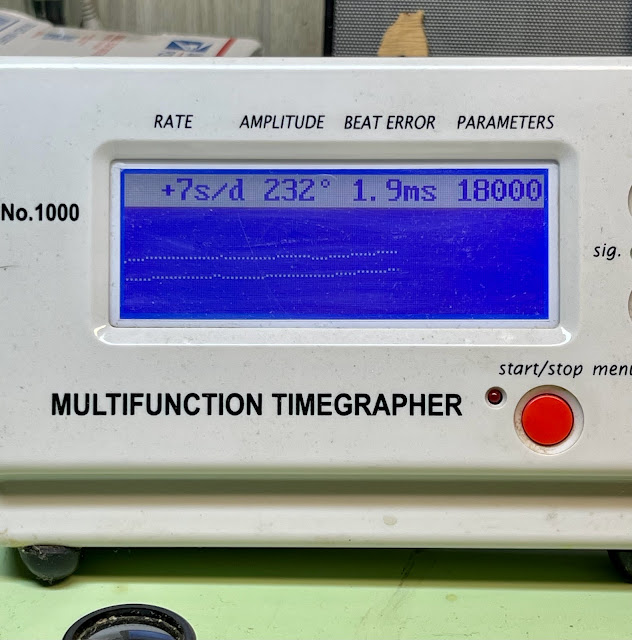It's been a while since I had a new model to showcase on the blog.
I was recently sent a 1951 Craig in need of some TLC. You don't tend to see them very often but I don't know if I'd call it "rare". The model was introduced in 1951 and produced for two years. So it's arguably an uncommon model, relative to the models made for longer periods of time.
The watch was purchased at auction and listed as "serviced" but I usually take that with a large grain of salt. As you'll see in this post, my advice to collectors is to "first buy the seller", as in "are they credible, do they accept returns, etc?".
My immediate impression upon opening the package was the dial is refinished and the wrong second hand is installed. The watch is NOT running.
From a slightly different angle you can see the plastic crystal is cracked.
With the bezel out of the way I can see there is glue on the dial between the 5 and 6 hours. So someone glued the crystal in with the dial installed, or they didn't let the glue dry before assembling the case.
Tucked inside the case of the Craig you will see an 8/0 sized 747 movement. The 730 movement would eventually replace the 747 but not during the production range of the Craig. The movement looks clean but the balance doesn't swing freely.
The inside of the case back is clearly marked with the model name. This was fairly common in the 1950s.
.
The back of the dial reveals the obvious tells that the dial is refinished. There are numbers scratched in and glue applied to keep the rivets holding the gold figures in place.
So what exactly does a "serviced watch" imply? After the 15+ years I've been collecting Hamiltons I have seen a lot of different excuses for "service". One example is fresh oil is applied to all the jewels... bang - serviced! Another is you take the dial and hands off and then bathe the fully-assembled movement in a cleaning solution, then dry it and add oil. Then you have the "take apart, clean, and reassemble" process - that's not too bad but there are some parts that you really ought to check before reusing. The last example is what you see me illustrate... fully disassemble, clean, inspect, and reassemble with proper lubrication, and finally - time the watch so that it's got a good beat error, amplitude and beat rate.
The mainspring barrel on this watch does not look freshly cleaned and I can immediately tell you the mainspring is likely "set" in a tight(ish) coil.
There... as I thought, the coil is a little larger than a quarter. This mainspring would power a watch for less than 24 hours. I would not have called this a "serviced" watch (not to mention it doesn't even run).
The owner sent along a plastic crystal but I happen to have a glass version. Originally the watch would have had a glass crystal - it's a Hamilton, after all. I jest a little but in all seriousness, in 1951 this watch cost roughly $61. That's equivalent to $720+ in 2023 dollars. This was not an inexpensive watch.
I'll prep a new Dynavar mainspring to power the watch. With a fresh mainspring the watch should run in excess of 35 hours.
Everything is cleaned, dried, and ready to be reassembled.
Despite my best efforts - I could not get the movement to run. I suspect that this watch was "serviced" by someone who screwed it up somehow, got frustrated, and then sold it on eBay. I've had to walk in other people's footsteps before... sometimes it's a mine field.
On to plan B... repeat the process with a donor movement. Actually that was plan C. Plan B was to use other parts like pallet forks and balances on the original movement and no-dice. There is something seriously amiss with the original movement. Like Dirty Harry said, "A man has got to know his limitations"... I am not equipped nor skilled enough to fix every issue a watch can have. I'm not the first person to think of swapping movements and it's totally okay as long as it's an appropriate caliber.
So ... fast forward to a new movement and the reassembled movement is ticking away with a good motion.
The watch timer agrees - this watch is running very nicely.
The finished project is complete with a new glass crystal and a proper second hand. It now looks and runs exactly as a "serviced watch" ought.



























